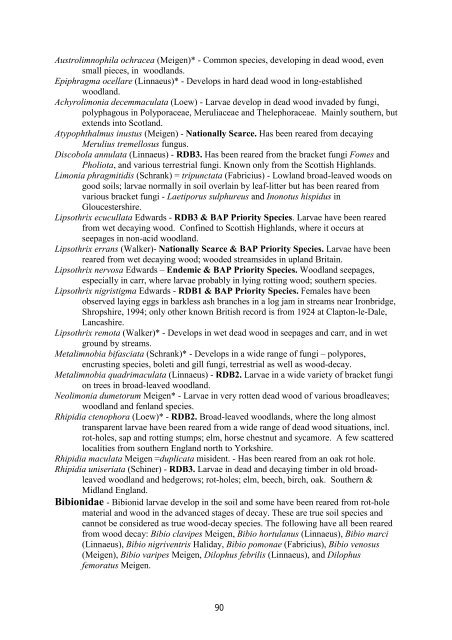Crustacea: Copepoda - Cerambycoidea.com
Crustacea: Copepoda - Cerambycoidea.com
Crustacea: Copepoda - Cerambycoidea.com
Create successful ePaper yourself
Turn your PDF publications into a flip-book with our unique Google optimized e-Paper software.
Austrolimnophila ochracea (Meigen)* - Common species, developing in dead wood, even<br />
small pieces, in woodlands.<br />
Epiphragma ocellare (Linnaeus)* - Develops in hard dead wood in long-established<br />
woodland.<br />
Achyrolimonia decemmaculata (Loew) - Larvae develop in dead wood invaded by fungi,<br />
polyphagous in Polyporaceae, Meruliaceae and Thelephoraceae. Mainly southern, but<br />
extends into Scotland.<br />
Atypophthalmus inustus (Meigen) - Nationally Scarce. Has been reared from decaying<br />
Merulius tremellosus fungus.<br />
Discobola annulata (Linnaeus) - RDB3. Has been reared from the bracket fungi Fomes and<br />
Pholiota, and various terrestrial fungi. Known only from the Scottish Highlands.<br />
Limonia phragmitidis (Schrank) = tripunctata (Fabricius) - Lowland broad-leaved woods on<br />
good soils; larvae normally in soil overlain by leaf-litter but has been reared from<br />
various bracket fungi - Laetiporus sulphureus and Inonotus hispidus in<br />
Gloucestershire.<br />
Lipsothrix ecucullata Edwards - RDB3 & BAP Priority Species. Larvae have been reared<br />
from wet decaying wood. Confined to Scottish Highlands, where it occurs at<br />
seepages in non-acid woodland.<br />
Lipsothrix errans (Walker)- Nationally Scarce & BAP Priority Species. Larvae have been<br />
reared from wet decaying wood; wooded streamsides in upland Britain.<br />
Lipsothrix nervosa Edwards – Endemic & BAP Priority Species. Woodland seepages,<br />
especially in carr, where larvae probably in lying rotting wood; southern species.<br />
Lipsothrix nigristigma Edwards - RDB1 & BAP Priority Species. Females have been<br />
observed laying eggs in barkless ash branches in a log jam in streams near Ironbridge,<br />
Shropshire, 1994; only other known British record is from 1924 at Clapton-le-Dale,<br />
Lancashire.<br />
Lipsothrix remota (Walker)* - Develops in wet dead wood in seepages and carr, and in wet<br />
ground by streams.<br />
Metalimnobia bifasciata (Schrank)* - Develops in a wide range of fungi – polypores,<br />
encrusting species, boleti and gill fungi, terrestrial as well as wood-decay.<br />
Metalimnobia quadrimaculata (Linnaeus) - RDB2. Larvae in a wide variety of bracket fungi<br />
on trees in broad-leaved woodland.<br />
Neolimonia dumetorum Meigen* - Larvae in very rotten dead wood of various broadleaves;<br />
woodland and fenland species.<br />
Rhipidia ctenophora (Loew)* - RDB2. Broad-leaved woodlands, where the long almost<br />
transparent larvae have been reared from a wide range of dead wood situations, incl.<br />
rot-holes, sap and rotting stumps; elm, horse chestnut and sycamore. A few scattered<br />
localities from southern England north to Yorkshire.<br />
Rhipidia maculata Meigen =duplicata misident. - Has been reared from an oak rot hole.<br />
Rhipidia uniseriata (Schiner) - RDB3. Larvae in dead and decaying timber in old broadleaved<br />
woodland and hedgerows; rot-holes; elm, beech, birch, oak. Southern &<br />
Midland England.<br />
Bibionidae - Bibionid larvae develop in the soil and some have been reared from rot-hole<br />
material and wood in the advanced stages of decay. These are true soil species and<br />
cannot be considered as true wood-decay species. The following have all been reared<br />
from wood decay: Bibio clavipes Meigen, Bibio hortulanus (Linnaeus), Bibio marci<br />
(Linnaeus), Bibio nigriventris Haliday, Bibio pomonae (Fabricius), Bibio venosus<br />
(Meigen), Bibio varipes Meigen, Dilophus febrilis (Linnaeus), and Dilophus<br />
femoratus Meigen.<br />
90

















